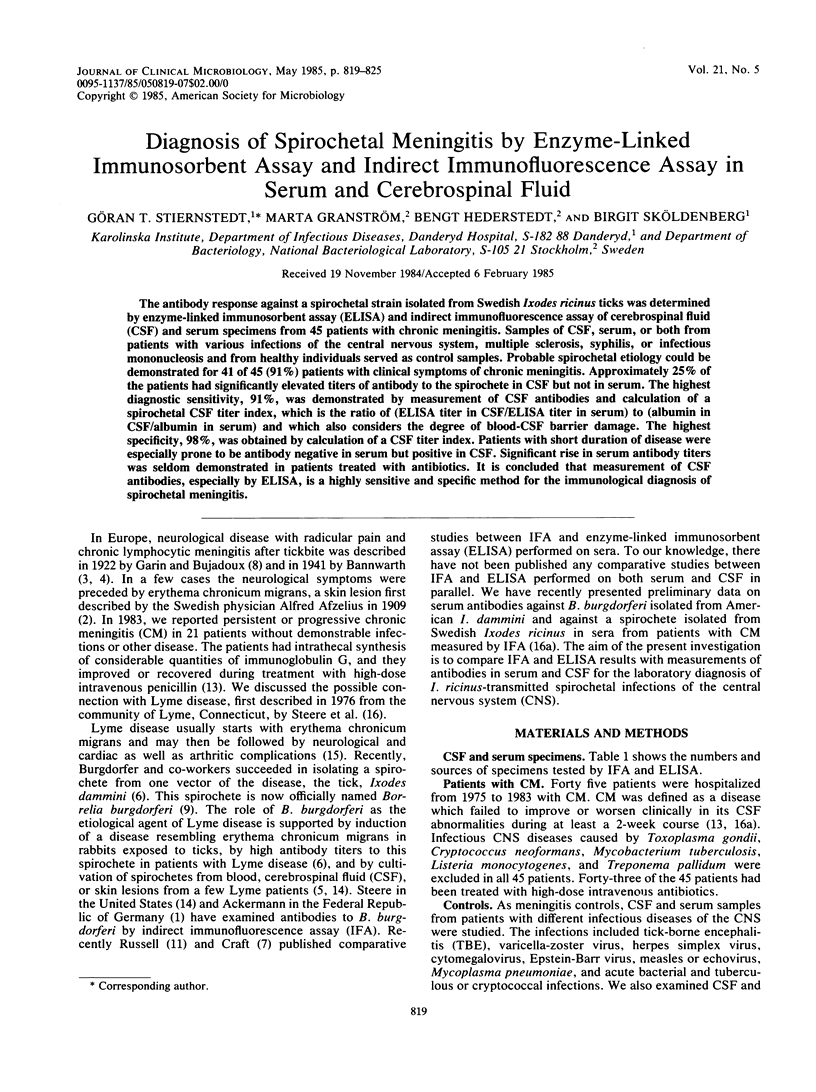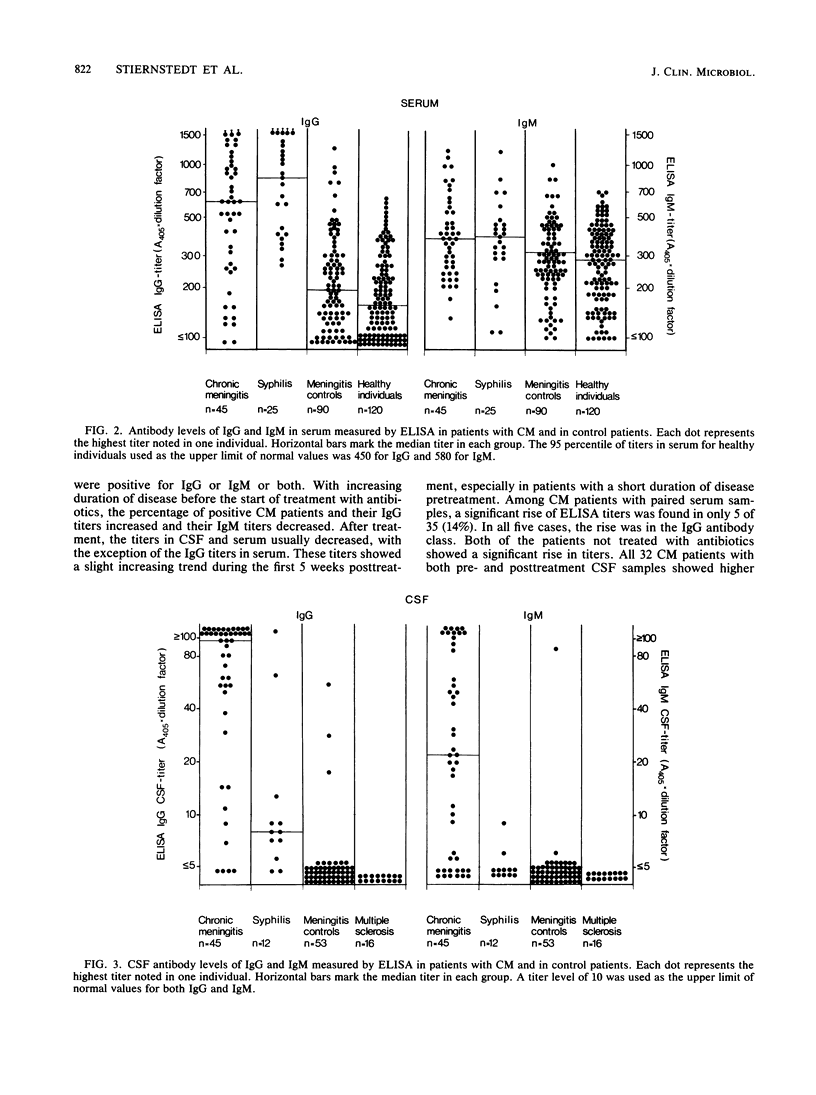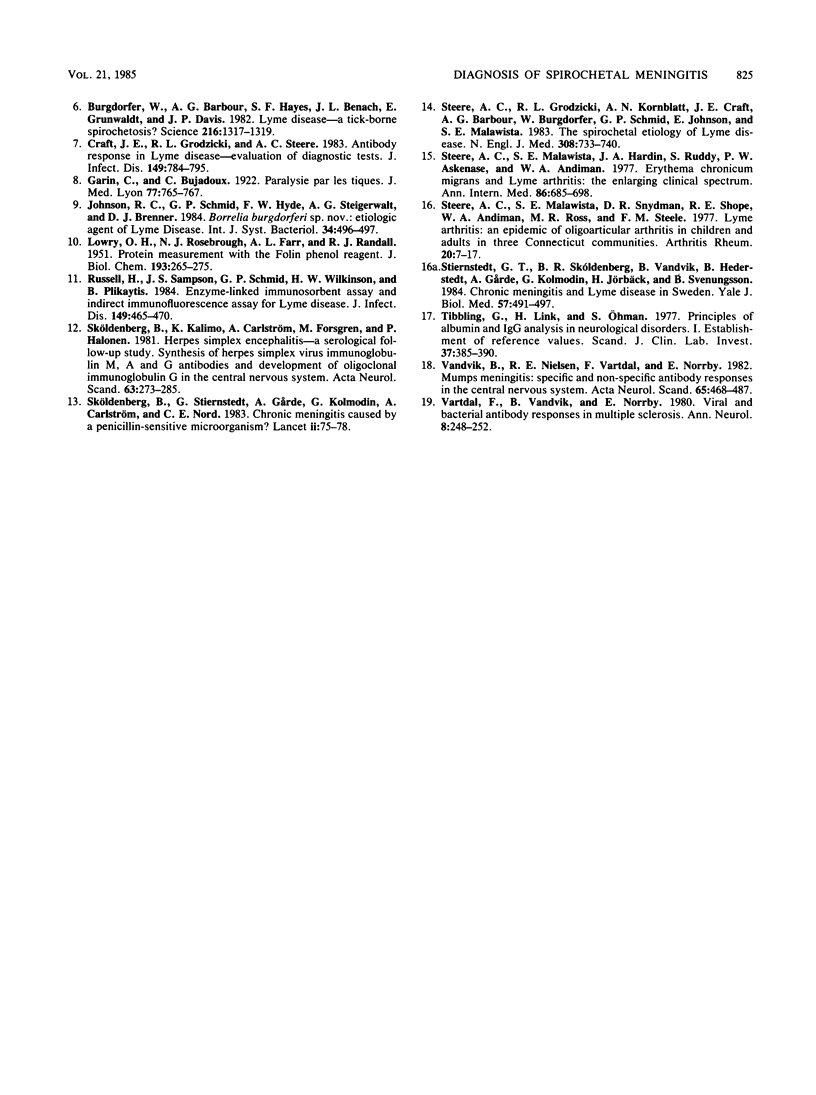Abstract
The antibody response against a spirochetal strain isolated from Swedish Ixodes ricinus ticks was determined by enzyme-linked immunosorbent assay (ELISA) and indirect immunofluorescence assay of cerebrospinal fluid (CSF) and serum specimens from 45 patients with chronic meningitis. Samples of CSF, serum, or both from patients with various infections of the central nervous system, multiple sclerosis, syphilis, or infectious mononucleosis and from healthy individuals served as control samples. Probable spirochetal etiology could be demonstrated for 41 of 45 (91%) patients with clinical symptoms of chronic meningitis. Approximately 25% of the patients had significantly elevated titers of antibody to the spirochete in CSF but not in serum. The highest diagnostic sensitivity, 91%, was demonstrated by measurement of CSF antibodies and calculation of a spirochetal CSF titer index, which is the ratio of (ELISA titer in CSF/ELISA titer in serum) to (albumin in CSF/albumin in serum) and which also considers the degree of blood-CSF barrier damage. The highest specificity, 98%, was obtained by calculation of a CSF titer index. Patients with short duration of disease were especially prone to be antibody negative in serum but positive in CSF. Significant rise in serum antibody titers was seldom demonstrated in patients treated with antibiotics. It is concluded that measurement of CSF antibodies, especially by ELISA, is a highly sensitive and specific method for the immunological diagnosis of spirochetal meningitis.
Full text
PDF






Selected References
These references are in PubMed. This may not be the complete list of references from this article.
- Ackermann R., Kabatzki J., Boisten H. P., Steere A. C., Grodzicki R. L., Hartung S., Runne U. Spirochäten-Atiologie der Erythema-chronicum-migrans-Krankheit. Dtsch Med Wochenschr. 1984 Jan 20;109(3):92–97. doi: 10.1055/s-2008-1069145. [DOI] [PubMed] [Google Scholar]
- Benach J. L., Bosler E. M., Hanrahan J. P., Coleman J. L., Habicht G. S., Bast T. F., Cameron D. J., Ziegler J. L., Barbour A. G., Burgdorfer W. Spirochetes isolated from the blood of two patients with Lyme disease. N Engl J Med. 1983 Mar 31;308(13):740–742. doi: 10.1056/NEJM198303313081302. [DOI] [PubMed] [Google Scholar]
- Burgdorfer W., Barbour A. G., Hayes S. F., Benach J. L., Grunwaldt E., Davis J. P. Lyme disease-a tick-borne spirochetosis? Science. 1982 Jun 18;216(4552):1317–1319. doi: 10.1126/science.7043737. [DOI] [PubMed] [Google Scholar]
- Craft J. E., Grodzicki R. L., Steere A. C. Antibody response in Lyme disease: evaluation of diagnostic tests. J Infect Dis. 1984 May;149(5):789–795. doi: 10.1093/infdis/149.5.789. [DOI] [PubMed] [Google Scholar]
- LOWRY O. H., ROSEBROUGH N. J., FARR A. L., RANDALL R. J. Protein measurement with the Folin phenol reagent. J Biol Chem. 1951 Nov;193(1):265–275. [PubMed] [Google Scholar]
- Russell H., Sampson J. S., Schmid G. P., Wilkinson H. W., Plikaytis B. Enzyme-linked immunosorbent assay and indirect immunofluorescence assay for Lyme disease. J Infect Dis. 1984 Mar;149(3):465–470. doi: 10.1093/infdis/149.3.465. [DOI] [PubMed] [Google Scholar]
- Sköldenberg B., Kalimo K., Carlström A., Forsgren M., Halonen P. Herpes simplex encephalitis: A serological follow-up study. Synthesis of herpes simplex virus immunoglobulin M, A, and G antibodies and development of oligoclonal immunoglobulin G in the central nervous system. Acta Neurol Scand. 1981 May;63(5):273–285. [PubMed] [Google Scholar]
- Sköldenberg B., Stiernstedt G., Gårde A., Kolmodin G., Carlström A., Nord C. E. Chronic meningitis caused by a penicillin-sensitive microorganism? Lancet. 1983 Jul 9;2(8341):75–78. doi: 10.1016/s0140-6736(83)90061-2. [DOI] [PubMed] [Google Scholar]
- Steere A. C., Grodzicki R. L., Kornblatt A. N., Craft J. E., Barbour A. G., Burgdorfer W., Schmid G. P., Johnson E., Malawista S. E. The spirochetal etiology of Lyme disease. N Engl J Med. 1983 Mar 31;308(13):733–740. doi: 10.1056/NEJM198303313081301. [DOI] [PubMed] [Google Scholar]
- Steere A. C., Malawista S. E., Hardin J. A., Ruddy S., Askenase W., Andiman W. A. Erythema chronicum migrans and Lyme arthritis. The enlarging clinical spectrum. Ann Intern Med. 1977 Jun;86(6):685–698. doi: 10.7326/0003-4819-86-6-685. [DOI] [PubMed] [Google Scholar]
- Steere A. C., Malawista S. E., Snydman D. R., Shope R. E., Andiman W. A., Ross M. R., Steele F. M. Lyme arthritis: an epidemic of oligoarticular arthritis in children and adults in three connecticut communities. Arthritis Rheum. 1977 Jan-Feb;20(1):7–17. doi: 10.1002/art.1780200102. [DOI] [PubMed] [Google Scholar]
- Stiernstedt G. T., Sköldenberg B. R., Vandvik B., Hederstedt B., Gårde A., Kolmodin G., Jörbäck H., Svenungsson B. Chronic meningitis and Lyme disease in Sweden. Yale J Biol Med. 1984 Jul-Aug;57(4):491–497. [PMC free article] [PubMed] [Google Scholar]
- Tibbling G., Link H., Ohman S. Principles of albumin and IgG analyses in neurological disorders. I. Establishment of reference values. Scand J Clin Lab Invest. 1977 Sep;37(5):385–390. doi: 10.1080/00365517709091496. [DOI] [PubMed] [Google Scholar]
- Vandvik B., Nilsen R. E., Vartdal F., Norrby E. Mumps meningitis: specific and non-specific antibody responses in the central nervous system. Acta Neurol Scand. 1982 May;65(5):468–487. doi: 10.1111/j.1600-0404.1982.tb03104.x. [DOI] [PubMed] [Google Scholar]
- Vartdal F., Vandvik B., Norrby E. Viral and bacterial antibody responses in multiple sclerosis. Ann Neurol. 1980 Sep;8(3):248–255. doi: 10.1002/ana.410080305. [DOI] [PubMed] [Google Scholar]


